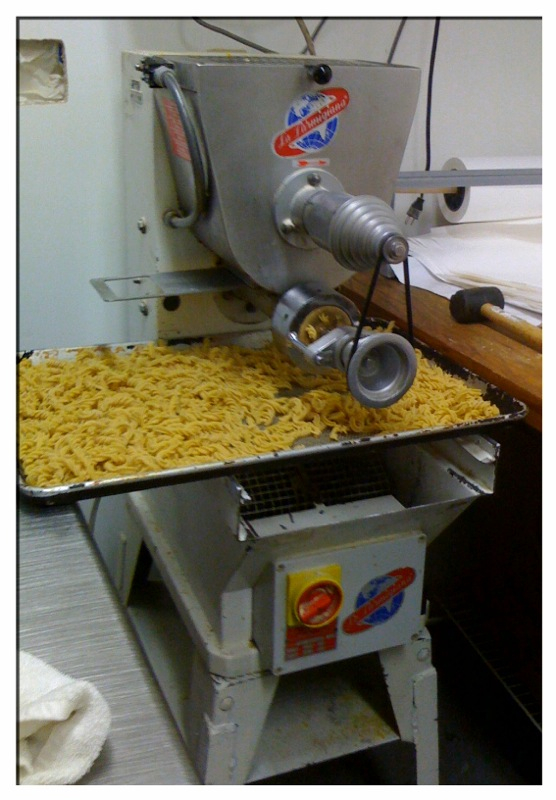
Pasta and Water published in Edible Santa Barbara Summer edition (Fresh Pasta Recipe)
Jul 20, 2011
Category 4
Category 3
Category 2
Category 1
We specialize in elevating content creators like you through bespoke social media strategies that not only capture attention, but also drive engagement.
Stride Social
Welcome to
One Pound of Pasta = 230 gallons of water
The Italian machine grows long linguine noodles with ease. The fresh pasta is dusted with the gold coarse powder of semolina and disappears into butcher paper before it remerges at the Santa Barbara Certified Farmer’s Market the next morning. I take one and a half pounds of The Solvang Pie Co. fresh naked pasta home. I dress the pasta with sautéed tomatoes, garlic, basil and shreds of parmesan. The lively dinner cadence is replaced by the silence of linguine noodles pirouetting around forks and the occasional loud slurp. Joaquin, my five year old interrupts the silence, “This is the best pasta I’ve ever had.” We all enthusiastically nod in agreement, mouths satiated with pasta.
Our family is not alone in our love affair for pasta. In the United States each person eats on average 17 pounds of pasta each year which translates to a water footprint of 3910 gallons of fresh water. The water footprint of 230 gallons per pound of pasta, roughly one package, reflects water required to grow the stalks of wheat and added ingredients.
Water footprint totals present the global average. The water footprint of food varies depending on the county, region, state and farm. All food has a different water story to tell depending on its origin. The water story of the pasta I serve on this night begins at a farm in Santa Ynez, California.
A welcoming committee of clucking chickens is the first to greet me on the seven acre farm of The Solvang Pie Co. tucked between a creek and hillside. About 350 chickens wander on this farm with Tracie Durban owner, her husband Fred and her baby Reagan. “My husband jokes that if I get any more chickens he will leave me for a cat lady,” laughs Tracy. The chickens eliminate her need for pesticides. They eat the slugs and other tasty bugs that feast on her apple trees.
In addition to pest control the chickens supply fresh eggs. “When I first began making pasta two years ago, the dough was sticky. After trial and error we realized that if we gather the eggs the morning we make pasta, without refrigeration, the dough is perfect.” The water footprint of a single egg is 23 gallons of fresh water. This reflects the average fresh water used to grow the feed, clean, and quench the thirst of an egg laying hen.
The water footprint of one egg largely reflects the embedded water to grow the feed for a chicken. Tracie’s chickens are raised with modest amounts of blue water. Water is colorless but researchers have assigned color. Blue water is sourced from ground water, reservoirs, and rivers that scribble across the landscape. Tracie’s chickens are on a diet of grass that grows between the lines of apples trees. Their favorite meal is the wheat germ mixed with scant amounts of water from her thirty acres of wheat fields in San Luis Obispo County.
The amber waves of wheat are grown on more land than any other crop in the world. The majority of wheat grown in the U.S has the friendly accent of a North Dakota farmer which grows enough durum for 13.7 billion servings of pasta each year. Most wheat in the world (90%) is grown with green water. This includes North Dakota wheat farms that rely exclusively on healthy rainfall.
Here, in California the acreage dedicated to wheat is growing, with 752,000 acres this year. Eighty percent of California wheat is grown on irrigatable land. That is to say that it is farmland that can be irrigated. Fewer farms require irrigation during robust rainy years like the one we are in. The majority of durum wheat called dessert durum is grown in the Imperial Valley. The dry valley relies on water from the Colorado River to sustain its wheat crops. A wheat farmer irrigates with either sprinkler or flood irrigation. Most opt for the cheaper flood irrigation which uses much more water than sprinklers.
After the rains between Thanksgiving and Christmas, Tracie with the help of her farmer husband, plant hard white wheat and durum. Most years the coastal moisture makes it possible for Tracie’s wheat farms to be rain fed. On very dry years her wheat will be watered with sprinkler irrigation once maybe twice before harvested in the summer. This year requires no irrigation.
“Do you use any chemicals on your wheat farms?” I ask. Chemicals can increase crop yields. Chemical application used on a farm make their eventual journey to fresh water sources. “Wheat is resistant to most pests limiting chemical use but occasionally we spray fungicides.” For the wheat farmer, fungus is the thief. In wet climates like North Dakota, or coastal California, fungus can wipe out an entire crop of wheat, leaving only the stalk. .“We spray fungicides about once every four years,” says Tracie. “We limit fungicide applications by yearly upgrades of seed, bred to resist new strands of fungus.” Organic wheat farms, according to USDA organic guidelines, disallow the use of synthetic chemicals and fertilizers.
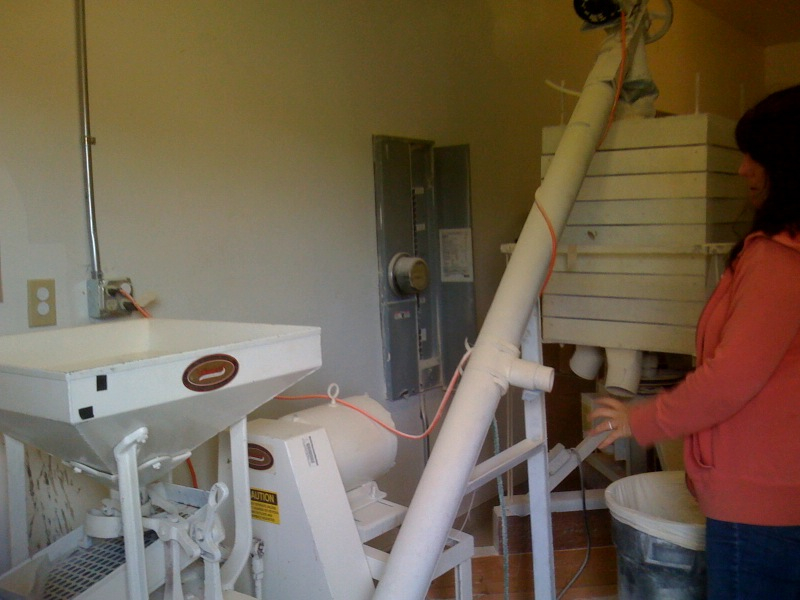 The room that houses the mill smells creamy sweet. The wheat berry sifts through nine screens of silk that separate the white flour from the wheat germ and bran. The mill vibrates masculine sounds. Wheat berries are rubbed between North Carolina granite and concrete. Stone ground flour is to be of better quality. Plastic bins lined with flannel catches the white flour that will age for two months before it is mixed into dough for the bakery. “What happens to the wheat germ?” I look to the bin holding the separated brown wheat. “Some of the wheat germ and bran is used in our baking but most is fed to the chickens.” Nothing is wasted on Tracie’s farm.
The room that houses the mill smells creamy sweet. The wheat berry sifts through nine screens of silk that separate the white flour from the wheat germ and bran. The mill vibrates masculine sounds. Wheat berries are rubbed between North Carolina granite and concrete. Stone ground flour is to be of better quality. Plastic bins lined with flannel catches the white flour that will age for two months before it is mixed into dough for the bakery. “What happens to the wheat germ?” I look to the bin holding the separated brown wheat. “Some of the wheat germ and bran is used in our baking but most is fed to the chickens.” Nothing is wasted on Tracie’s farm.
Tracie reduces waste through her diverse operation. The apples she grows for her pies are fertilized by the chickens that wander beneath them plucking pests from the soil. The chickens provide the eggs for the bakery, fed by the excess wheat germ.
Purchases from a diverse farm, like Tracie’s diminishes waste that occurs on the conventional journey of food to our plate. Food is wasted at each stop on the food production chain: farm, processing plant, supermarket, restaurant or home kitchen. Between thirty to fifty percent of all food produced never makes it to our mouths in the United States. All the food that lands in trash bins can be expressed in gallons of water.
Seventy percent of all water in the world is ultimately connected to the food we put on our plates. If the world’s water was contained in a gallon bucket, a single drop of water on the tip of your finger represents the amount of fresh water available in any given moment. The drop is equivalent to less than ½ of 1 percent. This drop of water has sustained life on the planet throughout the ages, yet it is predicted that two-thirds of the people living on this planet will experience water scarcity by 2025. If we are to ensure that we have abundant water sources for our growing human population we must take a hard look at how water is used for food production. Every meal we eat either stresses or sustains our fresh water supplies. I will continue to slurp the long linguine pasta from the Solvang Pie Co. For the most important water conservation begins at the kitchen table.
Homemade Pasta
8 servings or 2.8 pounds
Once you open the door to fresh pasta you won’t want it any other way. Tracie’s fresh pasta is available every weekend at the Santa Barbara Farmer’s Market. Here is fresh pasta recipe for home just in case you miss the farmer’s market. The Solvang Pie Co. sells wheat berries and durum for home milling. Ask about the bagged stone ground flour. This recipe can be used with or without a pasta machine. The pasta machine I use for this recipe is the Marcato Atlas 150.
2 cups flour
2 cups semolina flour
1 pinch salt
6 large eggs
2 tablespoons oil
Sift together the flour and salt.
Empty the flour mixture onto a clean counter surface. Form the flour into a mountain shape with a deep well in the center.
Break the eggs and add olive oil into the well. Whisk eggs with a fork. I find that I can add about three eggs and oil in the center well before it resembles an overflowing volcano. Once this happens, I start to knead the dough and create another well and add the remaining eggs.
Dust work surface with semolina as needed. Knead the dough until it is smooth and supple about 8-10 minutes.
Wrap dough tight in a plastic wrap at room temperature for 30 minutes.
Roll dough to your desired thickness and cut into your favorite noodle shape or refer to the directions provided with your pasta machine.
Place the fresh pasta on a dusted counter of semolina or hang on plastic hangers to keep noodles from sticking to each other.
Boil enough water to cover the noodles, 2 quarts for a pound of pasta (trust me this is all the water you need not 4-6 quarts normally suggested). Add 1 tablespoon of salt to season the pasta for every 2 quarts water. Add pasta noodles into the boiling water making sure they are separate pieces (not one big clump). Stir a few times to be sure the pasta does not stick together. Fresh pasta cooks quickly. Stay close. Check to see if it is done at 3 minutes. If not, check pasta in one minute increments thereafter.
Remove pasta from water. Save the pasta water to make your favorite sauce. The starchy salty water is excellent in pasta sauces, it thins the sauce, adds flavor and salt. Reusing the pasta water in sauces is common practice in Italy. Your water conservation will be rewarded in flavor. The pasta water adds a rich, buttery flavor to the sauce. You will find yourself wiping the plate clean.
Simple Tomato, Garlic, Basil Sauce with Pasta Water
4-6 serving
2 tablespoons ‘dry farmed’ olive oil *
4 garlic cloves, diced
2 pounds organic** tomatoes chopped into eights
1-2 ladles salted pasta water
1 bunch fresh basil, stemmed
*Dry farmed olive oil means that the olives are sourced from olive trees that use only green water (rain water) for irrigation. How do you know if olive oil is dry farmed? Ask.
**When available, I choose organic or pesticide-free vegetables. This action minimizes pesticide and synthetic fertilizer runoff into water systems. Ask farmers how they utilize rain water for irrigation and support those who implement water sustainable practices.
Sauté the garlic until it begins to brown in the olive oil.
Add tomatoes and sauté until soft.
Ladle 1-2 scoops pasta water to thin and season the pasta sauce. Simmer the sauce to allow for the flavors to marry. (Keep the extra water in the Refrigerate the extra pasta water to add to leftover pasta sauce for tomorrow’s lunch. The sauce is even tastier the next day.)
Turn the flame to low and add basil. Keep flame on just long enough for the basil to wilt about 2 minutes.
To serve, drape the sauce over your favorite pastas. Sprinkle drops of parmesan.
You can find The Solvang Pie Co. at the Santa Barbara Certified Farmer’s Market every Tuesday afternoon and Saturday morning or the Solvang Farmer’s Market every Wednesday. Visit them online at www.solvangpieco.com.
Find a copy of this article published in Edible Santa Barbara.
Leave a Reply Cancel reply
Ready to take Action?
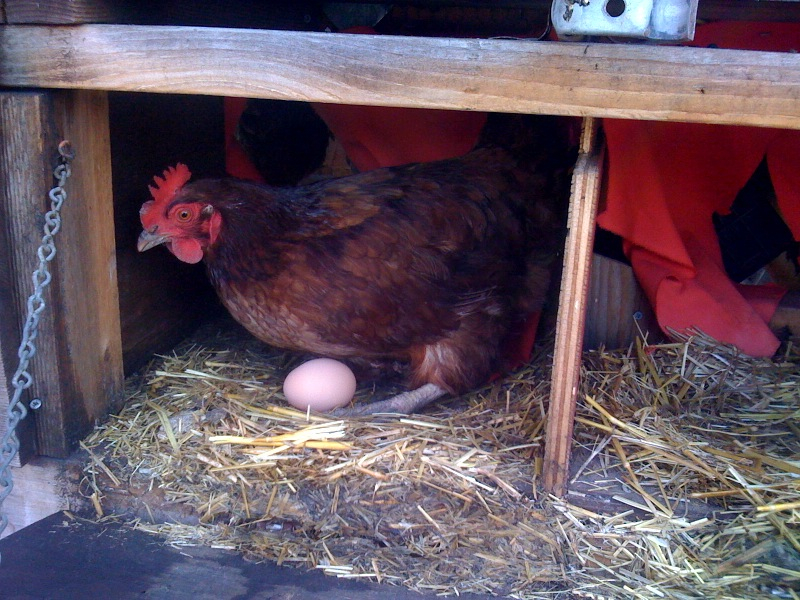
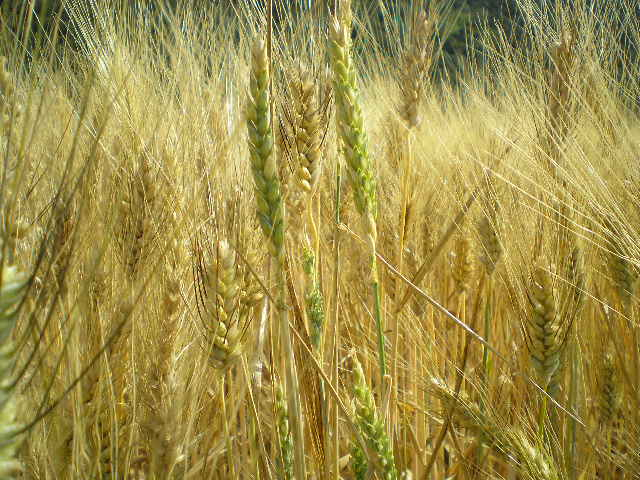
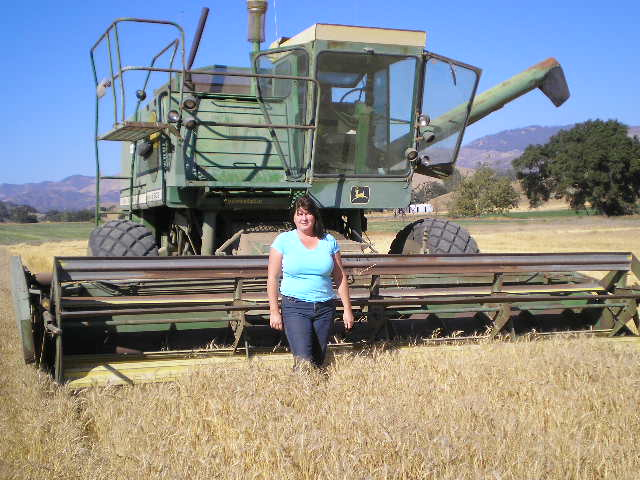

click to Read & Leave a comment
Click to close comments
Comments